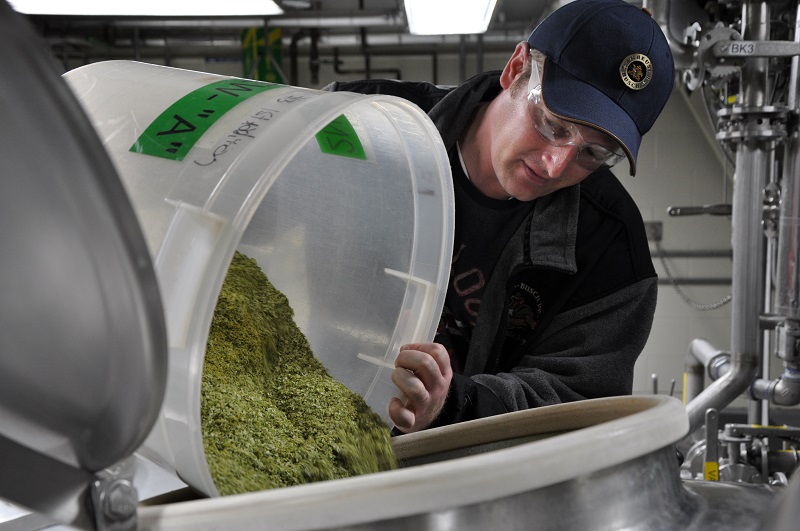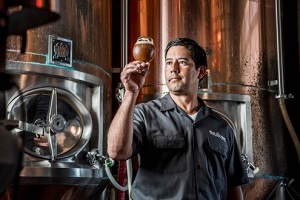Mad Science: Brewers Doing Small Things at Big Breweries

Rob Naylor of Anheuser-Busch’s Research Pilot Brewery. (Photo by Bryan Roth)
Every morning of the work week, Rob Naylor prepares to mash in on his 15-barrel brewing system. With malt selected from an upstairs storage and bags of hops pulled from a nearby cooler set at 36 degrees, he and his coworkers set controls to begin brewing one of an eclectic collection of beers.
Naylor oversees eight to 12 brews a week, which vary widely in style and ingredients, from an IPA featuring Mosaic, Centennial and El Dorado hops to a chipotle chocolate rauchbier and an oatmeal cookie beer that included cinnamon and was aged on dried cranberries. It’s a mix of novel recipes that drinkers might find in other innovative brewing spaces around the country.
Except Naylor works at Anheuser-Busch, best known for its light lagers. Tucked inside 1.6 million-square feet of AB’s St. Louis production facility, Naylor oversees Anheuser-Busch’s Research Pilot Brewery, an innovation hub taking up just 2 percent of that sprawling space, yet it often has 30 to 50 beers in development at any given time to test brewing techniques and ingredients.
Until November 2015, the public rarely got to try any of the mad scientist experiments created by Naylor and his staff to test ingredients from acidulated malt to ghost peppers and hawthorn berries.
Beers from the pilot brewery were typically shared with AB employees, used for consumer testing or brought to the occasional beer festival, but November marked the first time a beer was widely available for purchase. Anheuser-Busch’s on-site Biergarten restaurant now features a dedicated tap to serve beers made on AB’s littlest brewing system. The first was an IPA.
“It felt like having one of your children go out into the world, but the excitement was great,” said Naylor, manager and brewmaster of the Research Pilot Brewery. “I was probably checking Untappd more than I should have been, but was happy with some of the comments.”
At a time when breweries of all sizes are tinkering to find the next big thing to grab the attention from a feverish, beer drinking public, Naylor represents something of an unexpected find. He’s producing off-the-wall beers that sound more like something to find fermenting in the closet of a homebrewer than at the nation’s largest brewery. But his job reflects a growing need for the big boys of beer.
Small and local breweries aren’t the only ones fighting for shelf space and beer money, which is why many companies are investing in what can amount to test kitchens for brewing. Staff dedicated to experimentation and innovation are put in charge of not just playing with new ingredients to determine their viability for a new beer, but trying to crack the code of the next beloved beer.

Keith Villa, founder and head brewmaster of Blue Moon Brewing Co. (Photo courtesy MillerCoors)
“It can be really tough to get people to believe in a beer that’s seen as extreme or beyond the ordinary,” said Keith Villa, founder and head brewmaster of Blue Moon Brewing Co., a subsidiary of Tenth and Blake (the craft and import division of MillerCoors). “People thought I was crazy back when I started.”
That was 20 years ago, when Villa was given something of a carte blanche from his bosses to brew just about anything he could imagine inside the SandLot Brewery, attached to Denver’s Coors Field. On a souped-up five-gallon homebrew system, Villa made beers featuring sea salt, white pepper, hibiscus and of all things, chicken.
“I was reading an article about chicken broth and wanted to see what happened if we made a chicken beer,” he recalled. “I put in four or five cans of broth concentrate and a small amount of chicken meat. Very few people wanted to try that beer.”
Of course, Villa’s experimentation also caused him to play with using different percentages of wheat in a brew, which led to the creation of Blue Moon, one of the most popular-selling beers in the country.
Which goes to show how brewers’ ingenuity can also be a kind of alchemy, trying to spin hops, malt or just about any other ingredient into gold.
In Chico, California, the magic is taking place in a location no larger than a standard living room, where Terence Sullivan spent most of his 2015 making sure one of Sierra Nevada Brewing Co.’s newest releases tasted sweet and tart instead of showcasing unwanted notes of boiled cabbage.
Beginning in March, Sullivan, product manager for Sierra Nevada’s experimental nano brewery, began tests to create Otra Vez, a gose-style beer made with grapefruit and prickly pear cactus. Too little cactus puree and the beer took on a sweet watermelon character. Too much and it created an unmistakable taste of something more appropriate for a St. Patrick’s Day meal.
From March through November, it took more than 100 versions of the beer between test batches and taste testing to dial in the right balance of acidity and sweetness.
“There were a lot of sleepless nights thinking ‘is this shit going to work?’” said Sullivan, who’s worked with Sierra’s 20-gallon nano system since 2012. “When you start going down a road that’s so demanding and difficult, you can’t help but think you’re putting in all this effort and you just hope it’s going to work.”

Terence Sullivan, product manager at Sierra Nevada Brewing Co. (Photo courtesy Sierra Nevada Brewing Co.)
Once a recipe is dialed in using the nano system, it can be moved over to Sullivan’s pilot equipment, a 10-barrel setup. Along with testing ingredient viability like whole cherries versus a purée or testing different fruits for the brewery’s Ovila Abbey Ales series of Belgian-style beers, it’s allowed Sullivan to play with ideas of his own, like brewing with coconut water or making a beer from the second runnings of the mash from Bigfoot, Sierra Nevada’s barley wine.
“Every brewer is going to think about using weird ingredients at some point,” he said. “We owe it to ourselves to think outside the box, too.”
At Samuel Adams’ Boston brewery, a 20-gallon test system was pivotal in the creation of the company’s lineup of Rebel IPAs, allowing research and development brewer Eryn Bottens to toy around with amounts and varieties of hops. He even tested a range of temperatures across 20 degrees to pinpoint ideal dry-hopping settings to extract the most aroma from Simcoe, Amarillo and other hops.
But Bottens had two big tests in 2015 for beers that highlighted Sam Adams’ year-end plans.
There was Rebel Raw, the limited release double IPA with just enough brewed to ship to five major U.S. metro areas. Made with 6 pounds of hops per barrel, Bottens took about four months for recipe development, spending time filling conical fermenters with different hop varieties to test dry hopping qualities of each. From a 20-gallon batch, he would split a beer among three hop varieties, then blend samples together to try and match flavors.
He also had to determine a way to safely remove the hops from the beer, as there was potential to clog lines once the recipe was moved into production.
“We’re looking at how we can pull hops from the bottom of the kettle, but then how much beer is going to be stuck in the hops and what’s our efficiency going to be?” Bottens said.
That wasn’t all he was focused on, either. Bottens was charged with playing with nitro gas as a lead up to Samuel Adams’ release of canned nitro beers for 2016.
“We knew we wanted to make three kinds of nitro beers, so we played around with different styles to see what would react well with nitro instead of CO2,” Bottens said.
RELATED: Tasting the Samuel Adams Nitro Project Beers
While the brewery settled on a coffee stout, IPA and white ale, tests went across the board, filling up space in his test brewery with lagers, pale ales, Belgian sours and robust porters.
“By the time we release something to the public, it might have gone through dozens of iterations,” said Jim Koch, founder and chairman of Boston Beer, the parent company of Samuel Adams. “You feel a lot better knowing you’ve got people dedicated to all this testing.”
Bryan Roth is a North Carolina-based writer. Find him tweeting about beer at @bryandroth.

Awesome article!! I love to here about the time and efforts and passions of the Brewers to develop the next great taste.
Still homebrewers at heart :0) I love it!